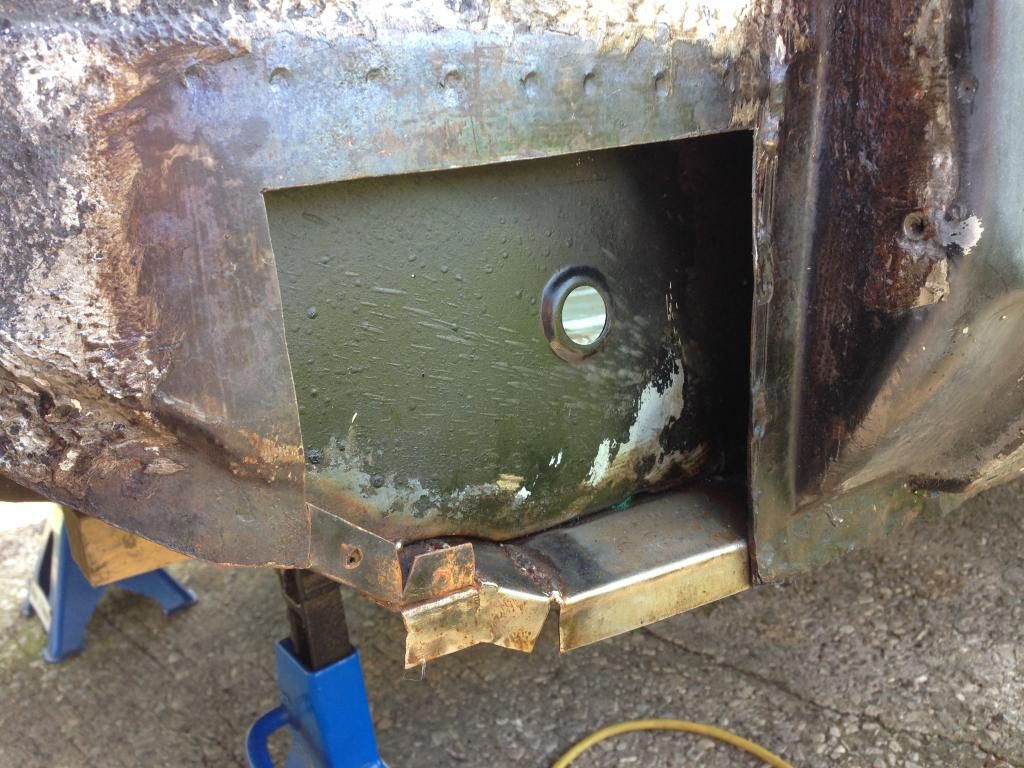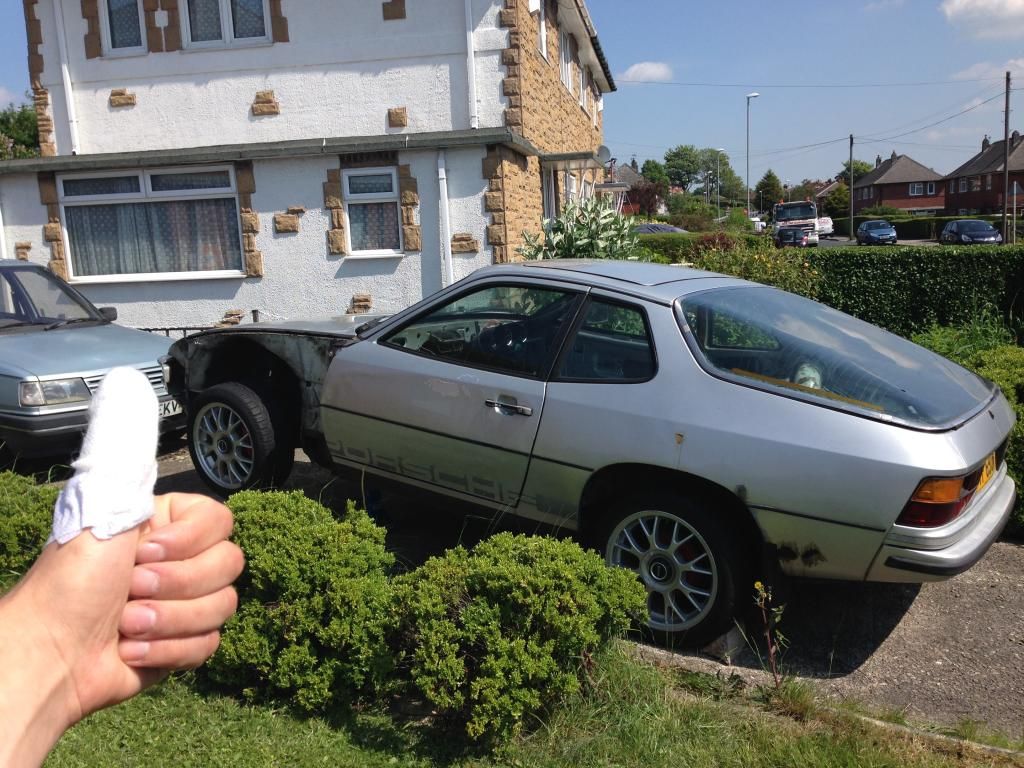stevek
Yorkshire and The Humber
Posts: 728
|
|
May 18, 2014 10:34:24 GMT
|
I am slowly making progress on the old 924, but am not sure how to protect the new metal. This is the section I'm closing up (I know it will need cleaning up again before welding)...  I thought 'Weld Through' primer was the stuff to use, but when I went to buy some last weekend but nowhere had any. I was told its normally expensive as it's quite specialist. I would have thought closing up a section and wanting some protection on the inside would be a common task so why is it hard to buy? Or am I looking at the wrong stuff? I can order it on-line easy enough but it describes it as being electrically conductive so that spot welders can arc through it, again making me think I may be looking at the wrong product. Whats the right way to get some protection inside a closed section? And whats Weld Through primer for? Cheers, Steve PS. The latest inconvenience to delay 924 progress...  |
| |
|
|
|
|
|
|
|
May 18, 2014 10:45:09 GMT
|
|
|
| |
Last Edit: May 18, 2014 10:46:16 GMT by mactat2
|
|
omega
Posted a lot
  
Posts: 1,060
|
|
May 18, 2014 11:20:02 GMT
|
|
why not fill it with underseal, then weld on the patch but leave a smallhole in it that you can get a probe in then either use a grommet to fill the hole or weld it up
|
| |
|
|
|
|
|
May 18, 2014 11:54:03 GMT
|
|
Hi!
I prefere to use zinc spray (99% zinc) as (weld-)primer. And then lots of wax or - better - grease. Grease requires heating to spray, though. And depending on the cavity, it's perhaps neccesary to drill a smal hole to get access with a cavity probe. I prefere grease for two reasons: it's cheap and it keeps creeping everywhere. Wax stays where you sprayed it too. And the trick bit with protecting a closed section is: you can't see where you got coverage and where not.
I use medical petroleum jelly to also have controll over hazardous substances... The kind used by tattoo shops etc.
Whilst weld through primer CAn be welded - unlike normal paint/primer - it still burns off at the weld. Same as zinc spray. It's always difficult to correctly treat welds in closed section of overlaping joint. I think grease or other geasy/oily substances are still the est way to overcome this. Maybe you even could apply primer/paint with a cavity probe. But the same problem persists; you can't check if everything's been covered.
A welded section is a repair. And not a restoration. It'll always be problematic. Just better than rotten tin... and correctly treated long lasting.
|
| |
|
|
|
|
|
May 18, 2014 12:27:54 GMT
|
|
Weld it first then spray it with wax, underseal or whatever you like for protection, just don't do it first as it burns really really well, and inside a sealed section it will be difficult to put out. If you need access for probes to spray through you can always plug the holes with rubber gromits
|
| |
|
|
|
|
|
May 18, 2014 16:10:28 GMT
|
|
I used cold galv spray for cavities that will be closed off. Accepted it will burn off at the weld points but if you ensure the cold galv is fully cured (24hrs +) then only a small part is affected.
Paul H
|
| |
|
|
|
|
|
May 18, 2014 17:58:08 GMT
|
|
I've used some weld-through primer (I think it was from LB Restoration) but it's really just a water paint that isn't supposed to burn. I have to scrape it off to get the MIG to strike though. I've found that other sections I've just painted with normal aerosol primer then welded in have probably retained just as much of that as of the specialist stuff. Halfords used to sell U-Pol weld-through primer, but I don't like it in aerosol as it's wasteful.
You want to put something on the flanges where there are two pieces welded together to simulate a spot weld, and something on the bare metal inside that cavity. On the bits away from the flange I'd probably put something like POR-15 or basically anything as the majority of it will stay. Then your choice of cavity wax / grease / whatever. Dinitrol is supposed to greep into seams better than the others, but I haven't tried it.
|
| |
|
|
stealthstylz
Club Retro Rides Member
Posts: 14,955
Club RR Member Number: 174
Member is Online
|
|
May 18, 2014 21:12:06 GMT
|
|
Its more time consuming, but what I do is paint both sides of the flange first with a combination of zinc primer and top coat. I then clamp the 2 sections together and use a blunt drill bit through the (pre drilled) plug weld holes to clean off the paint ready for welding. The best way ive found to paint inside the cavities (and ive only done this on a couple of customers cars as its time consuming and therefore expensive, is to drill a hole at the highest point. I then use a huge syringe to brim the box section with paint, before drilling a hole at the lowest point and allowing the excess to drain out. It sounds a lot more long winded than it is tbf.
|
| |
|
|
|
|
|
May 18, 2014 21:12:24 GMT
|
I presume you haev a grommet hole in the picture that is accessable  ? if this is the case then weld it up and simply fill it up the waxoil......if you don't have and access hole then dsimply drill a 10mm hole and then waxoil and us e arubber grommet to seal it up. Dave |
| |
|
|
|
|
|
May 25, 2014 23:15:33 GMT
|
|
|
| |
|
|
|
|
|
May 26, 2014 15:29:21 GMT
|
|
If it's completely closed, then a good zinc-based weld through primer (personally I swear by the Bilt Hamber stuff, it's great) is about the best you'll get, yes, a bit will burn off behind the weld, but the zinc is sacrificial anyway, so it shouldn't matter.
If there's access/a small hole somewhere you can get a tube in, then fill it with Dynax S50, it's a cavity wax that crammed full of anti-oxidisers for rust protection, and it creeps a long way, so even if you miss some, chances all it'll creep along the surface and coat it anyway.
|
| |
|
|
stevek
Yorkshire and The Humber
Posts: 728
|
|
|
|
Hi Everyone, Be assured I read every post very thoroughly to take everything in. There has been such a strong response it difficult to reply to everyone in detail. I did go with the Frosts Weld-thru stuff mactat2 linked to in the end, though I gather it's basically a high zinc content Zinc Galv spray as others had advised too. I have made sure to coat both inside surfaces of the seam as droopsnoot recommended. penrhynrallycentre noticed there are access holes in the sill section already so I will also check out some Dinitrol cavity wax or maybe the other stuff Blown_Imp has spotted. Thanks for the help everyone, It overwhelmingly proves the helpful nature of Retro-Rides. -Steve- Ps you can see what I did over HERE |
| |
Last Edit: Jun 8, 2014 17:40:59 GMT by stevek
|
|

















 ? if this is the case then weld it up and simply fill it up the waxoil......if you don't have and access hole then dsimply drill a 10mm hole and then waxoil and us e arubber grommet to seal it up.
? if this is the case then weld it up and simply fill it up the waxoil......if you don't have and access hole then dsimply drill a 10mm hole and then waxoil and us e arubber grommet to seal it up. [*]
[*] [*]
[*]

